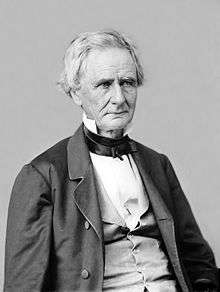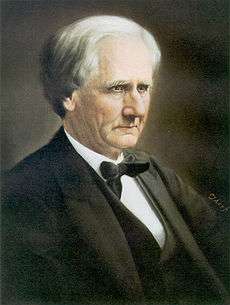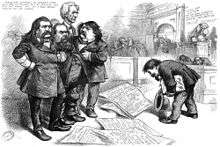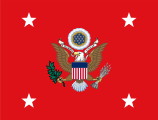Simon Cameron
Simon Cameron (March 8, 1799 – June 26, 1889)[1] was an American businessman and politician. He represented Pennsylvania in the United States Senate and served as United States Secretary of War under President Abraham Lincoln at the start of the American Civil War.
Simon Cameron | |
|---|---|
 | |
| United States Senator from Pennsylvania | |
| In office March 4, 1867 – March 12, 1877 | |
| Preceded by | Edgar Cowan |
| Succeeded by | J. Donald Cameron |
| In office March 4, 1857 – March 4, 1861 | |
| Preceded by | Richard Brodhead |
| Succeeded by | David Wilmot |
| In office March 13, 1845 – March 3, 1849 | |
| Preceded by | James Buchanan |
| Succeeded by | James Cooper |
| United States Minister to Russia | |
| In office June 25, 1862 – September 18, 1862 | |
| President | Abraham Lincoln |
| Preceded by | Cassius Clay |
| Succeeded by | Cassius Clay |
| 26th United States Secretary of War | |
| In office March 5, 1861 – January 14, 1862 | |
| President | Abraham Lincoln |
| Preceded by | Joseph Holt |
| Succeeded by | Edwin Stanton |
| Personal details | |
| Born | March 8, 1799 Maytown, Pennsylvania, U.S. |
| Died | June 26, 1889 (aged 90) Maytown, Pennsylvania, U.S. |
| Political party | Democratic (before 1849) American (1849–1856) Republican (1856–1877) |
| Spouse(s) | Margaret Brua |
| Signature | |
A native of Maytown, Pennsylvania, Cameron made a fortune in railways, canals, and banking.[2] As a member of the Democratic Party, he won election to the Senate in 1845, serving until 1849. A persistent opponent of slavery, Cameron briefly joined the Know Nothing Party before switching to the Republican Party in 1856. He won election to another term in the Senate in 1857 and sought the Republican presidential nomination at the 1860 Republican National Convention. After the convention's first ballot, Cameron withdrew his name from consideration in favor of Lincoln, who went on to win the Republican nomination.
After Lincoln won the presidential election of 1860, he appointed Cameron as his first Secretary of War. Cameron's tenure was marked by allegations of corruption and lax management, and he was forced to resign in January 1862. He briefly was the U.S. ambassador to Russia later that year. Cameron made a political comeback after the Civil War, winning election to the Senate in 1867. Cameron built a powerful state party machine that would dominate Pennsylvania politics for the next seventy years. He was a US Senator until 1877, when he was succeeded by his son, J. Donald Cameron.
Early and family life
Simon Cameron was born in Maytown, Pennsylvania in 1799,[2] to Charles Cameron (d. January 16, 1814) and his wife Martha McLaughlin (d. abt. November 10, 1830).[3]
Cameron was the third of five sons; and had three younger sisters. One story claimed that Cameron was orphaned at nine, and later apprenticed to a printer, Andrew Kennedy, editor of the Northumberland Gazette before entering the field of journalism. If Cameron were apprenticed to Kennedy at age nine (~1808) for a then-standard period of seven years, he would have become a journeyman printer at age 16 (~1815).[3] On October 17, 1822 in Harrisburg, Pennsylvania, Cameron married Margaret Brua (1794-1875).[4]
Career
Early printing and business careers
Cameron was editor of the Bucks County Messenger in 1821. A year later, he moved to Washington, D.C., and studied political movements while working for the printing firm of Gales and Seaton. Cameron purchased and ran the Harrisburg Republican in 1824.

Cameron became the state printer of Pennsylvania from 1825 until 1827, and was state adjutant general in 1826. He constructed several rail lines and merged them into the Northern Central Railway, of which his son became Vice-President. Cameron founded the Bank of Middletown in 1832 and engaged in other business enterprises. In 1838, he was appointed as commissioner to settle claims of the Winnebago Indians. This role would later haunt him politically, as he acquired the derisive nickname "Winnebago Chief" after allegedly cheating the tribe in a supply contract.[5]
Prewar politics

Cameron began his political career as a Democrat, supporting the campaigns of Andrew Jackson and Martin Van Buren.[6] He was elected to replace James Buchanan in the United States Senate in 1845, serving until 1849.[2] A persistent opponent of slavery, Cameron switched to the Know Nothing Party, before joining the Republican Party in 1856.[7] In 1857, Cameron was again elected to the US Senate.[2]
At the 1860 Republican National Convention, Cameron controlled the votes of the Pennsylvania delegation. He delivered those votes to Abraham Lincoln for the nomination for President, which proved decisive. In return, Lincoln's managers promised a Cabinet post for Cameron.
American Civil War
When Lincoln became President, he reluctantly appointed Cameron Secretary of War, and Cameron arranged that Pennsylvania Railroad vice-President Thomas A. Scott would be made assistant secretary of war (the Pennsylvania railroad delivered its long haul freight destined for Baltimore to the North Central at Harrisburg, Pennsylvania).[8] Cameron's tenure as Secretary of War was marked by allegations of corruption and lax management. On April 18, 1861, the day after Virginia seceded from the Union, Virginia militia seized the federal arsenal at Harpers Ferry, which was also an important work station on the rival Baltimore and Ohio Railroad's main westward line. Soon B&O president John Work Garrett received letters from Virginia's Governor John Letcher both telling the B&O to pass no troops destined for any place in Virginia over the railroad, and threatening the line's confiscation. Charles Town's mayor threatened to cut the B&O's main line by destroying the long bridge over the Potomac River at Harpers Ferry, and Garrett also received anonymous threats. Thus he and others asked Cameron to protect the B&O as the national capitol's main westward link. Cameron instead warned Garrett that passage of any rebel troops over his line would be treason. The Secretary of War agreed to station troops to protect the North Central, the Pennsylvania Railroad and even the Philadelphia, Wilmington and Baltimore Railroad, but flatly refused to help the B&O.[9]
The B&O had to repair damaged line at its own expense, and often received late or no payment for services rendered to the federal government.[10] On June 20, 1861, Confederates seized Martinsburg, a major B&O work center. Within weeks, CSA General Stonewall Jackson (who had blown up the Harpers Ferry bridge on June 14), went from allowing trains to pass through Martinsburg between 11a.m. and 1p.m. to confiscating dozens of locomotives and train cars and ripping up double track in order to ship rails for Confederate use in Virginia (14 locomotives and 83 rail cars were dismantled and sent south, and another 42 locomotives and 386 cars damaged or destroyed at Martinsburg, with the B&O water station and machine shops also destroyed and 102 miles of telegraph wire removed by the time federal control was restored in March 1862).[11]
Since Jackson cut the B&O main line into Washington for more than six months, the North Central and Pennsylvania Railroads profited from overflow traffic, even as many B&O trains stood idle in Baltimore. Garret tried to use his contacts to secure the needed protection, from Maryland Delegate Reverdy Johnson to General George McClellan and Treasury Secretary Salmon P. Chase. As winter began, coal prices soared in Washington, even though the B&O in September arranged for free coal transport from its Cumberland, Maryland terminal down the C&O Canal (which reduced prices somewhat, although Confederates also damaged the C&O canal that winter). Furthermore, western farmers could not get their produce to markets because of the B&O shutdown, only partially alleviated by the summer 1861 Union army victories at the Battle of Philippi (West Virginia) and Rich Mountain, and vigorous army and company work crews which reduced the main line gap to 25 miles between Harpers Ferry and Back Creek.[12]

Finally, Samuel M. Felton, the President of the Philadelphia, Wilmington and Baltimore Railroad notified newspapers of the War Department's discrimination against his competing and cooperating railroad line. President Lincoln (familiar with railroad law since his days as an Illinois lawyer) in January 1862 replaced Cameron with Pennsylvania lawyer Edwin M. Stanton, who had been serving as Cameron's legal advisor.[13] Furthermore, on January 31, 1862 Congress passed the Railways and Telegraph Act of January 31, 1862, creating the United States Military Railroad and allowing it to seize and operate any railroad or telegraph company's equipment, although Stanton and USMRR Superintendent Daniel McCallum would take a "team of rivals" approach to railroad management and allow civilian operations to continue.[14] In February 1862, Union forces recaptured Martinsburg and Harpers Ferry, and work crews continued replacing wrecked bridges and equipment, although bushwhacker raids continued.[15]
Cameron's brother, James Cameron, colonel of the 79th New York Volunteer Infantry Regiment, was killed in action at the First Battle of Bull Run on July 21, 1861.
Nonetheless, Cameron's corruption became so notorious that U.S. Representative Thaddeus Stevens (also from Pennsylvania), when asked whether Cameron would steal, said: "I don't think that he would steal a red hot stove."[2] (Cameron demanded Stevens retract this insult. Stevens said to Lincoln "I believe I told you he would not steal a red-hot stove. I will now take that back.") After Stanton's promotion, Cameron became Minister to Russia.[2]
Postwar political boss
Cameron made a political comeback after the Civil War, building a powerful state party machine that would dominate Pennsylvania politics for the next seventy years.[7] In 1866, Cameron was again elected to the Senate.
Cameron convinced his close friend Ulysses S. Grant to appoint his son, James Donald Cameron, as Secretary of War in 1876.[7] Later that year, Cameron helped Rutherford B. Hayes win the Republican nomination in 1876.[7] Cameron resigned from the Senate in 1877 after assuring that his son would succeed him. Though Cameron also had intended for his son to succeed him as head of the state machine, Matthew Quay ultimately succeeded Cameron as the party boss.[16]
Death
Cameron retired to his farm at Donegal Springs Cameron Estate near Maytown, Pennsylvania where he died on June 26, 1889.[2] He is buried in the Harrisburg Cemetery in Harrisburg, Pennsylvania.[2] Cameron County, Pennsylvania, and Cameron Parish, Louisiana, are named in his honor.
Legacy
According to historian Hans L. Trefousse, Cameron ranks as one of the most successful political bosses in American history. It was shrewd, wealthy, and devoted his talents in money to the goal of building a powerful Republican organization. He achieved recognition as the undisputed arbiter of Pennsylvania politics. His assets included business acumen, sincere devotion to the interests and needs of Pennsylvania, expertise on the tariff issue and the need for protection for Pennsylvania industry, and a skill at managing and organizing politicians and their organizations. He cleverly rewarded his friends, punished his enemies, and maintain good relations with his Democratic counterparts. His reputation as an unscrupulous grafter was exaggerated by his enemies; he was in politics for power, not profit.[17]
As a young man his prudent investments in publishing, banking, manufacturing and railroads provided both a financial bankroll, and wide insights into key industries that boosters across Pennsylvania wanted to support. Originally an anti-abolitionist Democrat, Cameron moved to the Whig party by the mid-1840s. When the Democrats factionalized in 1845, he joined with insurgent Democrats and mainline Whigs to win election to the Senate. Again in 1857 he put together a coalition of Republicans, Know Nothings, and Democratic insurgents to win the legislatures vote for Senator. He waged a bitter dispute with governor-elect Andrew Curtin, but nevertheless it 1860 made himself the state's favorite son at the Republican national convention. He was not a serious contender for the presidency, but his control of the Pennsylvania delegation gave him a lock on a high position Lincoln's cabinet. Cameron was a poor secretary of war, unable to deal with the small-mindedness, the inefficiencies, and the fraud that pervaded contracts. He had little sense of national politics or military strategy. Biographer Paul Kahan says he was very good as a “back-slapping, glad-handing politician,” who could manipulate congressmen. But he was too disorganized, and inattentive to the extremely complex duties of the largest and most important federal department. He paid too much attention to patronage and then not enough to strategy.[18] He broke with Lincoln and openly advocated emancipating the slaves and arming them for the army at a time Lincoln was not ready to publicly take that position.[19] Lincoln sent him to Russia but continued to consult him. After the war, Cameron became the state party boss, returning to the Senate in 1867 and perfecting his machine. He used highly able lieutenants including Matthew Quay. Robert W. Mackey and his son Donald Cameron. In national politics he was a Radical Republican who opposed President Andrew Johnson and became a key advisor to President Ulysses Grant. President Rutherford Hayes dislike Cameron, but was outmaneuvered.[20]
See also
- List of American politicians who switched parties in office
- Simon Cameron House and Bank, Middletown, Pennsylvania
- Simon Cameron House, Harrisburg, Pennsylvania
- Simon Cameron School, Harrisburg, Pennsylvania
References
- Baker, Jean (1999). "Cameron, Simon". American National Biography. New York: Oxford University Press. doi:10.1093/anb/9780198606697.article.0400195. (subscription required)
- "Cameron, Fritchie are luminaries of era". Intelligencer Journal. February 7, 2011. Retrieved November 11, 2016.
- Lancaster, Pennsylvania, Mennonite Vital Records, 1750-2014 for Charles Cameron, accessed February 2018.
- Marriage of Simon Cameron and Margareth Brua; Historical Society of Pennsylvania; Philadelphia, Pennsylvania; Historic Pennsylvania Church and Town Records; Reel: 691, via ancestry.com paid subscription site accessed February 2018.
- McPherson, James M. (1988). Battle Cry of Freedom: The Civil War Era. Oxford, New York: Oxford University Press. ISBN 978-0-19-503863-7. p. 260
- "Simon Cameron". Tulane.edu. Tulane. Retrieved November 25, 2014.
- "Simon Cameron Historical Marker". Explore PA History.com. WITF. Retrieved November 25, 2014.
- Daniel Carroll Toomey, The War Came by Train: the Baltimore & Ohio Railroad during the Civil War (Baltimore and Ohio Railroad Museum 2013) p. 61 ISBN 978-1-886248-01-4
- Toomey pp. 41, 61-62, 83-84
- Toomey pp. 82-83
- Toomey pp. 108-110
- Toomey pp. 82-84
- Toomey pp. 62-63
- Toomey pp. 63, 181
- Toomey pp. 108-109
- Blair, William Alan (April 1989). "A Practical Politician: The Boss Tactics of William Stanley Quay". Pennsylvania History. 56 (2): 78–89.
- Hans L. Trefousse, "Cameron, Simon" in John A. Garraty, Encyclopedia of American Biography (1974), pp 165-167
- Paul Kahan, Amiable Scoundrel: Simon Cameron, Lincoln's Scandalous Secretary of War (2016) p167.
- Kahan, Amiable Scoundrel pp 192-194
- Trefousse, 1974
Further reading
- Bradley, Erwin Stanley (1966). Simon Cameron, Lincoln's Secretary of War: A Political Biography. Philadelphia, Pennsylvania: University of Pennsylvania Press. LCCN 65020756.
- Crippen, Lee Forbes (1942). Simon Cameron, Ante-Bellum Years. Oxford, Mississippi: Mississippi Valley Press. ISBN 0306703629.
- Furniss, Jack. "Andrew Curtin and the Politics of Union." Pennsylvania Magazine of History and Biography 141.2 (2017): 145-176.
- Kahan, Paul (2016). Amiable Scoundrel: Simon Cameron, Lincoln's Scandalous Secretary of War. University of Nebraska Press. ISBN 978-1-61234-814-8.
- Koistinen, Paul A. C. Beating Plowshares into Swords: The Political Economy of American Warfare, 1606-1865 (1996) pp 132-169.
- "Simon Cameron." Dictionary of American Biography (1936) Online.
External links
| Wikimedia Commons has media related to Simon Cameron. |
| Wikisource has the text of a 1911 Encyclopædia Britannica article about Simon Cameron. |
| Wikisource has original text related to this article: |
- Simon Cameron biography in Secretaries of War and Secretaries of the Army a publication of the United States Army Center of Military History
- Spartacus Educational: Simon Cameron
- Mathew Brady Studio: Simon Cameron
- biographic sketch at U.S. Congress website
- Biography at Lincoln Institute
- Mr. Lincoln and Friends: Simon Cameron
- The John Harris-Simon Cameron Mansion
| U.S. Senate | ||
|---|---|---|
| Preceded by James Buchanan |
U.S. Senator (Class 3) from Pennsylvania 1845–1849 Served alongside: Daniel Sturgeon |
Succeeded by James Cooper |
| Preceded by William L. Dayton |
Chair of the Senate Agriculture Committee 1845–1846 |
Succeeded by Jesse D. Bright |
| Preceded by Richard Brodhead |
U.S. Senator (Class 1) from Pennsylvania 1857–1861 Served alongside: William Bigler, Edgar Cowan |
Succeeded by David Wilmot |
| Preceded by Edgar Cowan |
U.S. Senator (Class 3) from Pennsylvania 1867–1877 Served alongside: Charles R. Buckalew, John Scott, William A. Wallace |
Succeeded by J. Donald Cameron |
| Preceded by John Sherman |
Chair of the Senate Public Buildings Committee 1867–1871 |
Succeeded by Oliver P. Morton |
| Preceded by Charles Sumner |
Chair of the Senate Foreign Relations Committee 1871–1877 |
Succeeded by Hannibal Hamlin |
| Political offices | ||
| Preceded by Joseph Holt |
United States Secretary of War 1861–1862 |
Succeeded by Edwin Stanton |
| Diplomatic posts | ||
| Preceded by Cassius Clay |
United States Minister to Russia 1862 |
Succeeded by Cassius Clay |
| Honorary titles | ||
| Preceded by Joseph Cilley |
Oldest living U.S. Senator 1887–1889 |
Succeeded by David Meriwether |
| Preceded by Henry Foster |
Most Senior Living U.S. Senator Sitting or Former 1889 |
Succeeded by Alpheus Felch James W. Bradbury |



